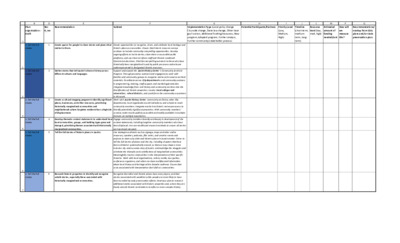Working version of implementation matrix — original pdf
Backup

B Plan organization - draft D Rec #_rev Recommendation Subtext Potential Participants/Partners Priority Level E F G H I J Implementation Type (Local policy change City code change, State law change, Other local gov't action, Additional funding/resources, New program, Adapted program, Further analysis, Further community/stakeholder process) (Low, Medium, High) Timeline (short-term, medium- term, long- term) L Resource level (low, med, high) M Estimated amount of funding needed/cost P How will we measure this? Q Recommendations/ overlap from COA plans and/or state preservation plan. 1 2 3 4 5 6 7 1. Tell the full stories Create spaces for people to share stories and places that matter to them. 1. Tell the full stories Gather stories that tell Austin’s diverse history across different cultures and languages. 1. Tell the full stories 1. Tell the full stories 1. Tell the full stories Create a cultural mapping program to identify significant places, businesses, and other resources, prioritizing historically marginalized communities and neighborhoods where longtime residents face a high risk of displacement. Develop thematic context statements to understand how local communities, groups, and building types grew and changed, prioritizing themes associated with historically marginalized communities. Tell the full stories of historic places in Austin. 1. Tell the full stories Research historic properties to identify and recognize untold stories, especially those associated with historically marginalized communities. 1 2 3 4 5 6 Create opportunities to recognize, share, and celebrate local heritage and historic places as necessities. Ensure that historic resource surveys continue to include community storytelling opportunities. Develop ongoing efforts to invite stories, share them on accessible public platforms, and use them to inform staff and Historic Landmark Commission decisions. Prioritize storytelling outreach to those who have historically been marginalized in and by public processes and who are underrepresented in designated historic resources. Support and expand the Austin History Center ’s Community Archivist Program. Through proactive outreach and engagement, work with families and community groups to recognize stories and conserve archival materials. Coordinate across City departments and community partners in programming, training, staff support, and marketing/promotion. Integrate knowledge from oral history and community archives into the identification of historic properties. Involve local colleges and universities , school districts , and youth from the community as partners in this work. Work with Austin History Center community archivists, other City departments, local organizations and institutions, and schools to reach community members. Integrate results into historic review processes to identify potentially significant properties. With community members’ consent, make results publicly accessible and readily available in multiple formats via multiple repositories. Engage community members broadly and deeply in development of the context statements, including longtime community members who have been displaced. Use non-traditional research methods to ensure all stories are heard and elevated. Use strategies and tools such as signage, maps and other online resources, speakers, podcasts, film series, and creative events and projects to share why older and historic places in Austin matter. Strive to tell the full stories of places and the city, including chapters that have been omitted or systematically erased, so that we may shape a more inclusive city and accurate story of Austin. Acknowledge the struggles and celebrate the triumphs and contributions of marginalized communities. Meaningfully involve communities in the interpretation of their specific histories. Work with local organizations, artists, media, tour guides, conference organizers, and others to share multifaceted information about local history and heritage with a broader audience. Ensure that costs associated with interpretation don’t fall on communities. Recognize that older and historic places have many layers, and that stories associated with wealthier white people are more likely to have been recorded by early preservation efforts. Develop a plan to research additional stories associated with historic properties and, where they are found, amend historic nominations to reflect a more complex history.